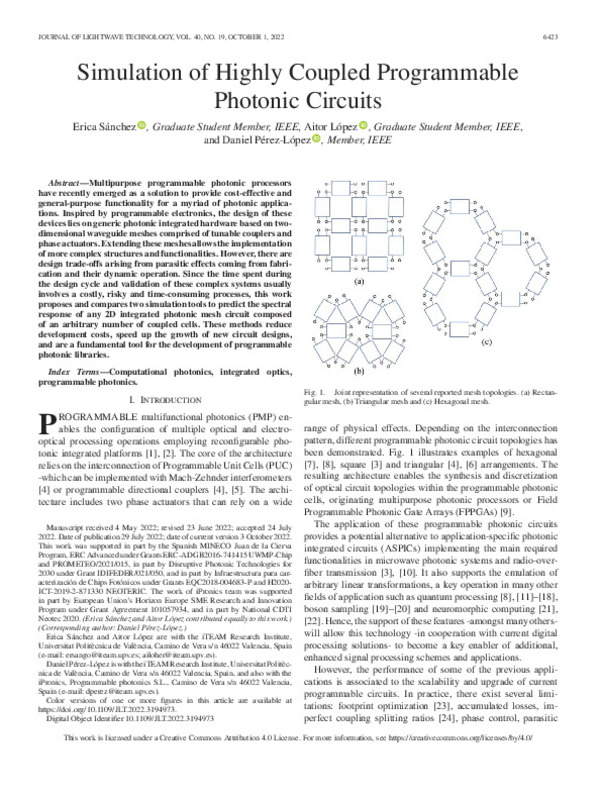JavaScript is disabled for your browser. Some features of this site may not work without it.
Buscar en RiuNet
Listar
Mi cuenta
Estadísticas
Ayuda RiuNet
Admin. UPV
Simulation of Highly Coupled Programmable Photonic Circuits
Mostrar el registro sencillo del ítem
Ficheros en el ítem
| dc.contributor.author | Sánchez-Gomáriz, Erica
|
es_ES |
| dc.contributor.author | López-Hernández, Aitor
|
es_ES |
| dc.contributor.author | Pérez-López, Daniel
|
es_ES |
| dc.date.accessioned | 2023-07-10T18:02:51Z | |
| dc.date.available | 2023-07-10T18:02:51Z | |
| dc.date.issued | 2022-10-01 | es_ES |
| dc.identifier.issn | 0733-8724 | es_ES |
| dc.identifier.uri | http://hdl.handle.net/10251/194786 | |
| dc.description.abstract | [EN] Multipurpose programmable photonic processors have recently emerged as a solution to provide cost-effective and general-purpose functionality for a myriad of photonic applications. Inspired by programmable electronics, the design of these devices lies on generic photonic integrated hardware based on two-dimensional waveguide meshes comprised of tunable couplers and phase actuators. Extending these meshes allows the implementation of more complex structures and functionalities. However, there are design trade-offs arising from parasitic effects coming from fabrication and their dynamic operation. Since the time spent during the design cycle and validation of these complex systems usually involves a costly, risky and time-consuming processes, this work proposes and compares two simulation tools to predict the spectral response of any 2D integrated photonic mesh circuit composed of an arbitrary number of coupled cells. These methods reduce development costs, speed up the growth of new circuit designs, and are a fundamental tool for the development of programmable photonic libraries. | es_ES |
| dc.language | Inglés | es_ES |
| dc.publisher | Institute of Electrical and Electronics Engineers | es_ES |
| dc.relation.ispartof | Journal of Lightwave Technology | es_ES |
| dc.rights | Reconocimiento (by) | es_ES |
| dc.subject | Photonics | es_ES |
| dc.subject | Graph Theory | es_ES |
| dc.subject | Simulation | es_ES |
| dc.subject | Computational photonics | es_ES |
| dc.subject | Integrated optics | es_ES |
| dc.subject | Programmable photonics | es_ES |
| dc.title | Simulation of Highly Coupled Programmable Photonic Circuits | es_ES |
| dc.type | Artículo | es_ES |
| dc.identifier.doi | 10.1109/JLT.2022.3194973 | es_ES |
| dc.relation.projectID | info:eu-repo/grantAgreement/EC/H2020/741415/EU | es_ES |
| dc.relation.projectID | info:eu-repo/grantAgreement/EC//101057934/ | es_ES |
| dc.relation.projectID | info:eu-repo/grantAgreement/EC/H2020/871330/EU | es_ES |
| dc.relation.projectID | info:eu-repo/grantAgreement/GVA//PROMETEO%2F2021%2F015/ | es_ES |
| dc.relation.projectID | info:eu-repo/grantAgreement/GVA//IDIFEDER%2F021%2F050/ | es_ES |
| dc.relation.projectID | info:eu-repo/grantAgreement/AEI//EQC2018-004683-P//INFRAESTRUCTURA PARA CARACTERIZACION DE CHIPS FOTONICOS/ | es_ES |
| dc.rights.accessRights | Abierto | es_ES |
| dc.description.bibliographicCitation | Sánchez-Gomáriz, E.; López-Hernández, A.; Pérez-López, D. (2022). Simulation of Highly Coupled Programmable Photonic Circuits. Journal of Lightwave Technology. 40(19):6423-6434. https://doi.org/10.1109/JLT.2022.3194973 | es_ES |
| dc.description.accrualMethod | S | es_ES |
| dc.relation.publisherversion | https://doi.org/10.1109/JLT.2022.3194973 | es_ES |
| dc.description.upvformatpinicio | 6423 | es_ES |
| dc.description.upvformatpfin | 6434 | es_ES |
| dc.type.version | info:eu-repo/semantics/publishedVersion | es_ES |
| dc.description.volume | 40 | es_ES |
| dc.description.issue | 19 | es_ES |
| dc.relation.pasarela | S\470240 | es_ES |
| dc.contributor.funder | European Commission | es_ES |
| dc.contributor.funder | Generalitat Valenciana | es_ES |
| dc.contributor.funder | Agencia Estatal de Investigación | es_ES |
| dc.contributor.funder | Centro para el Desarrollo Tecnológico Industrial | es_ES |
| upv.costeAPC | 5000 | es_ES |








